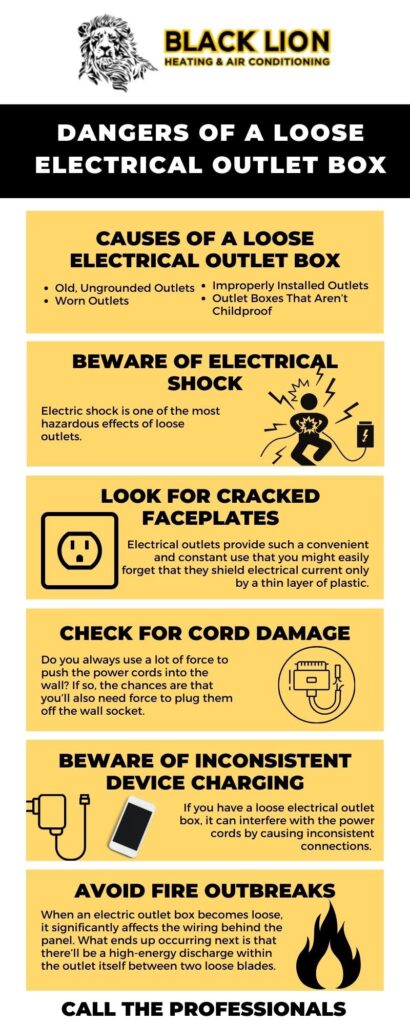
Electrical outlets are an essential part of modern life, providing power to our homes and devices. However, loose electrical outlets can pose a serious safety hazard, increasing the risk of electric shock and fire. Damaged or improperly installed outlets can expose live wires, allowing electricity to flow where it shouldn’t. This article will delve into the dangers of loose electrical outlets, provide guidance on identifying potential issues, and outline steps for safe repair and when professional help is necessary.
This comprehensive guide will explore the various safety hazards associated with loose electrical outlets, teach you how to recognize warning signs, and equip you with basic repair tips. We’ll also discuss the importance of calling a qualified electrician in certain situations to ensure your home remains a safe environment.
Electrical Outlet Safety Hazards
Loose electrical outlets create a dangerous pathway for electricity to flow, increasing the risk of several serious hazards:
- Electric Shock: When an outlet is loose, live wires can be exposed, allowing you or someone else to receive a potentially fatal electric shock if they come into contact with them. This is especially dangerous for children who may not understand the risks involved.
Fire Hazard: Loose connections in outlets generate heat, which can ignite nearby flammable materials like paper, curtains, or even wiring insulation. Over time, this heat buildup can lead to a fire, potentially causing significant damage to your property and endangering lives.
Device Damage: Loose outlets can also damage your electronic devices. Inconsistent power flow due to loose connections can cause malfunctions, overheating, and even permanent damage to sensitive components.
Signs of a Loose Electrical Outlet
Identifying potential problems early is crucial for preventing serious accidents. Look out for these common signs that indicate a loose electrical outlet:
- Outlet Feels Loose: If the outlet feels wobbly or loose when you plug something in, it’s a clear indication that the connection is not secure.
Sparks or Arcing: Any visible sparks or arcing around the outlet when you plug or unplug something are extremely dangerous signs of a faulty connection and require immediate attention from a qualified electrician.
Dimming Lights: If your lights flicker or dim noticeably when using appliances plugged into a particular outlet, it could be a sign of loose wiring causing inconsistent power flow.
- Burning Smell: A burning smell emanating from an outlet is a serious warning sign that something is overheating and potentially dangerous.
Dangers of Exposed Live Wires
Exposed live wires are incredibly hazardous and should never be touched.
Risk of Electric Shock:
Direct contact with exposed live wires can result in severe electric shock, which can cause muscle contractions, burns, cardiac arrest, and even death.
Fire Hazard:
Exposed wires can easily come into contact with flammable materials, creating a significant fire hazard. The heat generated by the electrical current can ignite nearby objects, leading to rapid fire spread.
Repairing Loose Electrical Outlets
While some minor repairs may be possible for DIY enthusiasts, it’s crucial to prioritize safety and consult a qualified electrician for any complex or potentially dangerous issues.
Basic Troubleshooting:
- Tighten Screws: If the outlet feels loose, try tightening the screws that secure it to the wall box. Use a screwdriver appropriate for the screw size and avoid overtightening.
- Check Connections: Carefully inspect the wires connected to the outlet terminals. Ensure they are securely clamped and haven’t become disconnected.
When to Call an Electrician:
For any repairs beyond basic tightening, it’s essential to call a licensed electrician. They have the expertise and tools to safely diagnose and repair electrical problems, minimizing risks and ensuring your home’s electrical system is functioning correctly.
When to Call an Electrician
While some minor repairs may be possible for DIY enthusiasts, certain situations always require the expertise of a qualified electrician:
- Exposed Wires: Never attempt to repair exposed wires yourself. This requires specialized knowledge and tools to ensure safety and proper insulation.
- Recurring Problems: If you experience repeated issues with an outlet, such as flickering lights or tripping breakers, it indicates a deeper problem that needs professional attention.
- Major Repairs: Any significant repairs involving rewiring, replacing the electrical box, or upgrading your electrical system should always be handled by a licensed electrician.
Conclusion
Loose electrical outlets pose a serious threat to safety, increasing the risk of electric shock, fire, and device damage. By understanding the potential hazards, recognizing warning signs, and knowing when to call a qualified electrician, you can protect yourself, your family, and your property from these dangers. Remember, prioritizing electrical safety is crucial for creating a secure and comfortable living environment.
